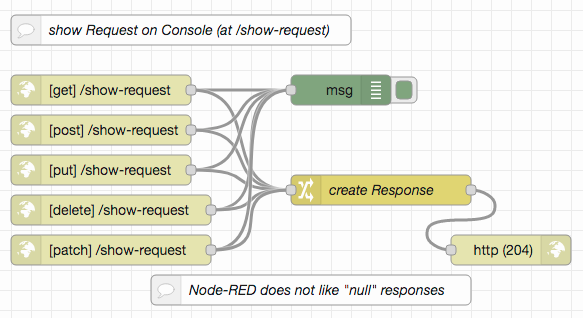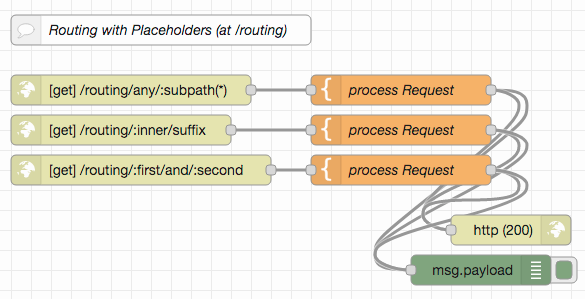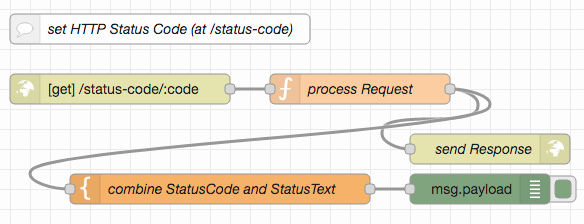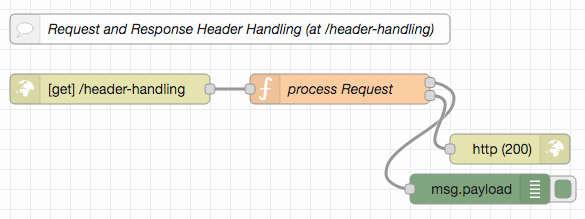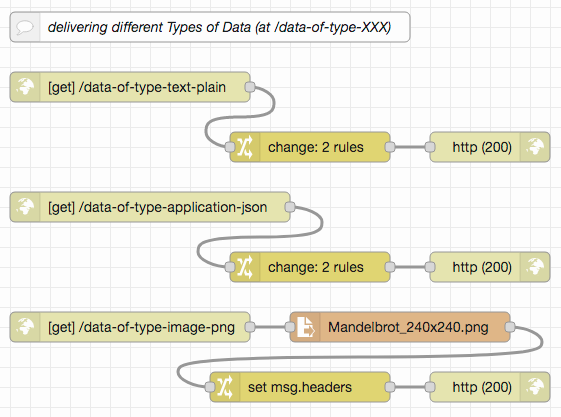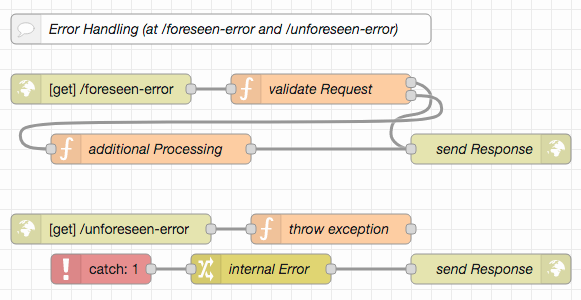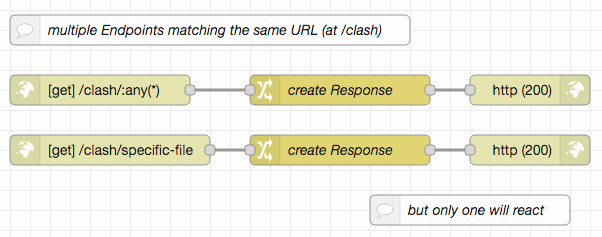node-red-http-endpoint-examples
This collection of HTTP(S)-related Node-RED examples (with a matching Postman collection for testing) is mainly intended for my students, but parts of it may also be of more general interest.
It demonstrates fundamental aspects of HTTP(S) endpoints in Node-RED and is continued in two additional contributions which demonstrate how to implement real (file-based) web servers or other REST services.
For this series, it is assumed that the reader already installed Node-RED (as described in Getting Started), optionally secured the editor (as shown in Securing Node-RED) and started using it (as explained in Creating your first flow)
Just a small note: if you like this work and plan to use it, consider "starring" this repository (you will find the "Star" button on the top right of this page), so that I know which of my repositories to take most care of.
Examples
All example specifications are stored in JSON format and may easily be imported into a Node-RED workspace. Preferrably, you should open a separate tab and insert them there.
To test the examples, a Postman collection is included, which may easily be imported into a running Postman instance. After the import, you should open the collection's "Variables" section and set the BaseURL to the base URL of your NodeRED instance (by default, it is set to 127.0.0.1:1880, which should work out-of-the-box for most Node-RED installations). If your Node-RED instance has been configured to require basic authentication, you should also set the variables Username and Password)
Alternatively, other tools like cURL may be used as well.
Trivial HTTP(S) Server
The first example is just to illustrate how easy it can be to implement a web service with Node-RED.
Import the source, "deploy" and send a GET request to {{BaseURL}}/trivial-http-server (where you replace {{BaseURL}} by the base URL of your Node-RED instance) - the enclosed Postman collection already includes such a request. The response includes a complete (albeit simple) HTML page - but any other result could be sent as well.
Show Request on Debug Console
For own developments, it is often useful to display the complete msg of an incoming HTTP request on the debug console.
Import the example, "deploy", send requests to {{BaseURL}}/show-request trying all HTTP methods Node-RED supports and inspect their output.
Routing (with Placeholders)
HTTP servers usually offer more than just a single endpoint - and often, parts of the requested URL control how the response will look like (in the simplest case, the URL contains the path of a file to be sent back).
Node-RED supports the creation of multiple HTTP endpoints and allows their configured URLs to contain "placeholders" (with or without a pattern the requested URL must match in order for the endpoint to be triggered). When matched, these placeholders will be set to the matching parts of the requested URL and may thus be used in response construction.
By default, a placeholder matches all characters up to (and without) the first "/" - if a complete subpath is needed, the placeholder should be followed by the pattern (*)
Import the routing example, "deploy" and use the included Postman collection to send various requests to {{BaseURL}}/routing. The examples have been programmed to respond with the values of their placeholders - provided that the corresponding endpoints get triggered...
Query Handling
URLs may contain a "query" with "parameters" and "values". Node-RED automatically parses incoming queries and makes their contents available under msg.req.query. Usually, the values found their are strings, but if the same parameter appears multiple times, its values are stored in an array
Import the query handling example, "deploy" and use the included Postman collection to send a request with an empty, a single and a multiple query parameter to {{BaseURL}}/query. The response will contain the actual contents of msg.req.query
Form Processing
An often needed feature of web applications (especially of application "frontends") is the submission of "forms". Node-RED is prepared to receive form contents and automatically parses them in order to simplify form processing.
Import the form processing example, "deploy" and use the included Postman collection to send a request to {{BaseURL}}/form-processing. The response sent back will contain several form variables and their values.
Please keep in mind that any form input will always be transmitted as text - boolean und numeric input may therefore first have to be converted into boolean and number values before being processed further
File Uploads
A common operation many servers provide is the upload of files. Node-RED supports file uploads out-of-the-box as part of their handling of POST requests.
Import the file upload example, "deploy" and use the included Postman collection to send a request to {{BaseURL}}/file-upload. As a "proof" of a successful file upload the response will contain the uploaded file's name and its MIME type.
Setting HTTP Status Codes
An important part of an HTTP response is its status code which informs the client about success or failure and - if the request failed - the reason for failure.
Node-RED allows the status code of a response to be explicitly set. This example combines this feature with URL placeholders and answers an incoming request with the status code it contains.
Import the status code example, "deploy" and use the included Postman collection to send requests for different status codes to {{BaseURL}}/status-code. Responses should contain the requested status code (if known) and a short explanation of their meaning
Request and Response Header Handling
Besides the actual content (the "body") HTTP requests and responses contain several "headers" with additional information about the request (or response). Node-RED allows incoming headers to be inspected and outgoing headers to be defined - both standard as well as non-standard headers are supported.
Import the header handling example, "deploy" and use the included Postman collection to test: it contains a request with a "custom-header" whose value will be returned when sent to {{BaseURL}}/header-handling. Don't forget to inspect the respopnse headers for the custom one.
Delivering different Types of Data
HTTP servers may deliver content of different types (as text or in binary form) and with different encodings. HTTP clients (such as browsers) determine the actual type of a response body with the aid of a header called "Content-Type".
Node-RED can send data in both text and binary form. While it may be able to "guess" the data type in some common situations, it is usually a good idea to set this header explicitly.
for this example to work, please copy file
Mandelbrot_240x240.pnginto the working directory of your Node-RED instance
Import the data type example, "deploy" and use the included Postman collection to send requests to {{BaseURL}}/data-of-type-text-plain, {{BaseURL}}/data-of-type-application-json and {{BaseURL}}/data-of-type-image-png. Because of the "Content-Type" header, Postman will be able to interpret the returned data properly and, e.g., present a returned image by displaying it.
Error Handling
An important aspect of request processing is the handling of errors - both "foreseen" and "unforeseen" ones.
"Foreseen" errors are simple: just check incoming requests and their contents for mistakes and react by responding with an appropriate HTTP status code. Common I/O and processing errors may be handled similarly using specific "catch" nodes.
Risky are all those errors the programmer does not think of - for those, a generic "catch" node dealing with all exceptions not otherwise caught should always be included and send an "Internal Server Error" (HTTP status code 500) back.
Import the error handling example, "deploy" and use the included Postman collection to send two requests: one to {{BaseURL}}/foreseen-error (which responds with 400 "Bad Request") and one to {{BaseURL}}/unforeseen-error (which responds with 500 "Internal Server Error")
Virtual Hosts
For web site hosters, it is quite common to handle multiple domains within the same server - a feature called "virtual hosts". Technically, these hosts are only distinguished by a special HTTP header (and with a lot of help from the requesting client).
And - since Node-RED supports headers, it also supports the handling of "virtual hosts".
Import the virtual host example, "deploy" and use the included Postman collection to send a request to {{BaseURL}}/virtual-hosts. The example will respond with the contents of the HTTP "Host" header - which is quite boring when used locally, but may principally be used to serve different domains from a single Node-RED instance
Multiple Endpoints matching the same URL
So far, we have seen several examples - all of them playing well together because of different HTTP endpoints. The question arises what happens if there is more than a single endpoint for the same URL (a situation which may easily occur if endpoints with placeholders are used)
Our final example addresses this problem: two different endpoints may handle the same URL. When tested (e.g., with the included Postman collection), only one of both endpoints will be triggered. Which one, depends on the order their creation - in practice, it is therefore a good idea to assume "unpredictable behaviour".
The important lesson to learn: Node-RED does not produce an error, not even a warning - it will be up to you to keep track of your endpoints and the range of URLs they cover.

